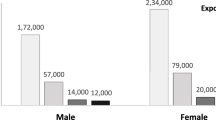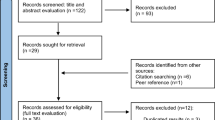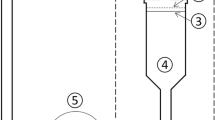Abstract
Consideration of the epidemiological evidence on radiogenic lung cancer in uranium miners and of the incidence of the disease generally leads to an upper estimate for the lifetime risk of 10−4 cases per working level month for members of the general population.
This is a preview of subscription content, access via your institution
Access options
Subscribe to this journal
Receive 51 print issues and online access
$199.00 per year
only $3.90 per issue
Buy this article
- Purchase on Springer Link
- Instant access to full article PDF
Prices may be subject to local taxes which are calculated during checkout
Similar content being viewed by others
References
Recommendations of the International Commission on Radiological Protection, Publ. 26 (Pergamon, Oxford, 1977).
Evans, R. D. Hlth Phys. 17, 229–252 (1969).
BEIR Report The Effects on Populations of Exposure to Low Levels of Ionizing Radiation, 372–397 (National Academy of Sciences, National Research Council, Washington DC, 1980).
Kusnetz, H. L. Am. ind. Hyg. Ass. Q. 17, 85–88 (1956).
Federal Register 40, 50704–50705 (1975).
Jacobi, W. Proc. NEA Specialist Meet. Personal Dosimetry and Area Monitoring Suitable for Radon and Daughter Products, Elliot Lake, Canada, 33–48 (Nuclear Energy Agency, OECD, Paris, 1977).
Richardson, H. P. Proc. NEA Specialist Meet. Personal Dosimetry and Area Monitoring Suitable for Radon and Daughter Products, Paris, 45–51 (Nuclear Energy Agency, OECD, Paris, 1979).
Swent, L. W. Testimony at Hearings on the Impact on Older Workers of Occupational Health Hazards, (US Senate Committee on Aging, Grants, New Mexico, 1979).
Myers, D. K. & Stewart, C. G. AECL-5970 (Chalk River Nuclear Laboratories, 1979).
Lundin, F. E., Wagoner, J. K. & Archer, V. E. NIOSH and NIEHS Joint Monogr. 1 (NTIS Springfield, 1971).
Sevc, J., Kunz, E. & Plaček, V. Hlth Phys. 30, 433–437 (1976).
Jacobi, W. Proceedings of NEA Specialist Meeting on Personal Dosimetry and Area Monitoring Suitable for Radon and Daughter Products, Paris, 223–230 (Nuclear Energy Agency OECD, Paris, 1979).
United Nations Scientific Committee on the Effects of Atomic Radiation, 1977 Report to the General Assembly, Annexes G & B (United Nations, New York, 1977).
Archer, V. E. Trans. Am. nucl. Soc. 33, 145–146 (1979).
Jacobi, W. & Eisfeld, K. GSF-Report S-626 (Institut für Strahlenschutz, München, 1980).
Breslin, A. J. & George, A. C. Trans. Am. nucl. Soc. 33, 150–152 (1979).
Cliff, K. D. Radiol. Prot. Bull. 22, 18–23 (1978).
Cliff, K. D., Davies, B. L. & Reissland, J. A. Nature 279, 12 (1979).
Rundo, J., Markun, F. & Plondke, N. J. Hlth Phys. 36, 729–730 (1979).
Ca-A Cancer Journal for Clinicians, 18–19 (1976).
Author information
Authors and Affiliations
Rights and permissions
About this article
Cite this article
Evans, R., Harley, J., Jacobi, W. et al. Estimate of risk from environmental exposure to radon-222 and its decay products. Nature 290, 98–100 (1981). https://doi.org/10.1038/290098a0
Issue Date:
DOI: https://doi.org/10.1038/290098a0
This article is cited by
-
A comprehensive review on sources of radon and factors affecting radon concentration in underground uranium mines
Environmental Earth Sciences (2016)
-
Evaluation of inhalation exposure contributed by backfill mill tailings in underground uranium mine
Environmental Earth Sciences (2015)
-
Determination of radon activity concentration in drinking water and evaluation of the annual effective dose in Hassan district, Karnataka state, India
Journal of Radioanalytical and Nuclear Chemistry (2015)
-
An investigation of factors influencing indoor radon concentrations in dwellings of Northern Rajasthan, India
Journal of the Geological Society of India (2015)
-
Passive integrating radon studies for environmental monitoring in Sirsa district, Haryana, India using solid state nuclear track detectors
Indian Journal of Physics (2009)
Comments
By submitting a comment you agree to abide by our Terms and Community Guidelines. If you find something abusive or that does not comply with our terms or guidelines please flag it as inappropriate.



